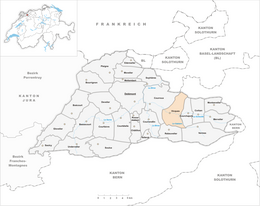Vicques, Switzerland
| Vicques | ||
|---|---|---|
| Former municipality of Switzerland | ||

Vicques village
|
||
|
||
| Coordinates: 47°21′N 07°25′E / 47.350°N 7.417°ECoordinates: 47°21′N 07°25′E / 47.350°N 7.417°E | ||
| Country | Switzerland | |
| Canton | Jura | |
| District | Delémont | |
| Government | ||
| • Mayor | Suzanne Maître | |
| Area | ||
| • Total | 12.75 km2 (4.92 sq mi) | |
| Elevation | 455 m (1,493 ft) | |
| Population (Dec 2011) | ||
| • Total | 1,763 | |
| • Density | 140/km2 (360/sq mi) | |
| Demonym(s) | Vicquois | |
| Postal code | 2824 | |
| SFOS number | 6727 | |
| Localities | Recolaine | |
| Surrounded by | Courchapoix, Vermes, Rebeuvelier, Courroux, Bärschwil(SO) | |
| Website |
www SFSO statistics |
|
Vicques is a former municipality in the district of Delémont in the canton of Jura in Switzerland. The municipalities of Montsevelier, Vermes and Vicques merged on 1 January 2013 into the new municipality of Val Terbi.
Jura Observatory is located above Vicques.
Vicques is first mentioned in 866 as Vicum.
Vicques had an area of 12.77 km2 (4.93 sq mi). Of this area, 5.9 km2 (2.3 sq mi) or 46.2% is used for agricultural purposes, while 5.86 km2 (2.26 sq mi) or 45.9% is forested. Of the rest of the land, 0.92 km2 (0.36 sq mi) or 7.2% is settled (buildings or roads), 0.08 km2 (20 acres) or 0.6% is either rivers or lakes and 0.03 km2 (7.4 acres) or 0.2% is unproductive land.
Of the built up area, housing and buildings made up 4.2% and transportation infrastructure made up 2.3%. Out of the forested land, 42.8% of the total land area is heavily forested and 3.1% is covered with orchards or small clusters of trees. Of the agricultural land, 23.0% is used for growing crops and 12.4% is pastures and 10.4% is used for alpine pastures. All the water in the municipality is flowing water.
The former municipality is located in the Delemont district, in the Val Terbi.
The blazon of the municipal coat of arms is Or, two Fishes Azure in saltire.
Vicques had a population (as of 2011[update]) of 1,763. As of 2008[update], 8.1% of the population are resident foreign nationals. Over the last 10 years (2000–2010) the population has changed at a rate of 7.6%. Migration accounted for -1.7%, while births and deaths accounted for 5.9%.
Most of the population (as of 2000[update]) speaks French (1,508 or 93.8%) as their first language, German is the second most common (53 or 3.3%) and Italian is the third (15 or 0.9%).
...
Wikipedia




